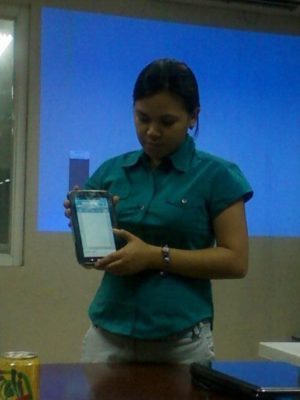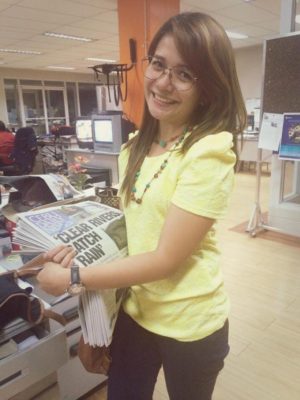CDN THROUGH THE YEARS: The rise of the digital-savvy Siloys

The current online team, Marc Eric Cosep, Doris Mae Mondragon, Korinna Lucero and Ray Charlie Diaz.
CDN PHOTO Jasson Magallanes
CONCLUSION
Digital technology presents an often bewildering array of choices for media organizations as it compels everyone to produce breaking news on their social media pages and on their websites, slideshows and videos, join social networks and blogs, and use mobile technology to enhance the delivery of news items online.
The process requires a deliberate understanding of all new technologies so that journalists and news producers can make an informed decision on why and how to utilize the digital world.

COSEP
While some newspapers are still clinging to traditional print reportage, major news organizations in the world are now adopting a “web-first” or “web-centric” approach in their workflow.
This means having reporters and editors produce text and multimedia content for the web, before writing a full text story on the print edition.
Cebu Daily News continues to evolve in that way.
While CDN began its venture into the digital realm in 2011, it was not until 2016 when it fully implemented the “tweet-to-print” concept advocated by Mario Garcia, a foremost adviser on news design, professor at Columbia University’s School of Journalism and a digital media consultant.
Using that concept, reporters and correspondents of CDN were taught to be multi-skilled journalists, which means they were no longer just writing for a newspaper, but also have to provide news content and breaking news — as close to real time as possible — through its social media (Twitter, Facebook and Facebook Live) platforms and website before writing their long form narratives for print publication.
It had it birth pains.

MONDRAGON
But reporters, correspondents and editors, who were steeped into the print journalism tradition, eventually evolved into journalists who can tweet, break stories on Facebook and on the website, do Facebook Live, shoot and edit videos, and close the day with a print story that wrapped up the day’s events they were tasked to cover.
As the reading public’s consumption of news and information shifted from mainly print to digital, so did CDN’s content.
As a result, its Facebook followers jumped from 20,000 in 2015 to today’s 684,000, with year-on-year engagements rising from barely 10,000 in 2015 to today’s 26 million.
The growth of CDN’s website was just as rapid, from 3.6 million pageviews for the whole of 2015 to 30 million this year, or from an average of 300,000 pageviews a month in 2015 to today’s 2.5 million pageviews a month.
As we close the printed pages of CDN to go fully digital on New Year’s Day 2019, we want you to get to know those who helped set the standards for online journalism in CDN, until it progressed as Cebu’s top digital news authority.

CODILLA
Marian Codilla
It was on June 14, 2011 when CDN’s pool of reporters and editors gathered at the CDN Library for their first introduction to digital journalism.
Codilla, a reporter covering the Cebu City Hall beat at that time, was asked by then publisher and Editor-in-Chief Eileen Mangubat to handle the paper’s online operation.
Taking up the challenge, Codilla envisioned the paper’s online platform to be at par with those of international news organizations like “The Guardian” and “The New York Times” despite its limited resources.
“It was hard because online journalism was not part of our course,” said Codilla, communications graduate who now works for the Central Visayas regional office of the Mines and Geosciences Bureau of the Department of Environment and Natural Resources.
Codilla recalled she “had to learn the ropes of online operation from scratch” and commissioned her friends Paul Ouano and April Reyes to help her set up a website for CDN.
The entire process took more than six months, which also included building a Fire Transfer Protocol (FTP) system that will allow minimal human intervention in uploading stories online.
“We spent over P90,000 before inquirer.net asked us to migrate to WordPress, and (I also learned),” she said.
(Inquirer.net or Dotnet, a separate company under the Inquirer Group of Companies [IGC], had by then started hosting the CDN website. CDN belonged to Inquirer Publications Inc., another company in the IGC that also publishes Bandera and Inquirer Libre. Philippine Daily Inquirer, on the other hand, is the national newspaper or the flagship company among the 11 autonomous companies under IGC.)
With the CDN online hosted by Dotnet, its following grew. And even though the work required spending long hours largely to transfer and position CDN’s print contents — news, sports, lifestyle, opinion, business, etc. — to its website, Codilla said she loved the challenges it brought.
“I loved the challenge and I always love to initiate action, so even if it wasn’t in the system before, I tried to influence the people into becoming mobile journalists,” Codilla said.
It was during Codilla’s time as multimedia coordinator when CDN became the first Facebook and Twitter pages to get verified on social media, from among the three local dailies in Cebu.
CDN was also able to sell its online photos to international news organizations while it continued to grow its digital presence with its then average website pageviews of 300,000 per month.

YAP
Aileen Yap
Yap was not among the CDN reporters who submitted breaking stories back when the newspaper launched its online platforms.
However, when she assumed the role of multimedia coordinator in 2016, Yap began to realize the importance of staying ahead of the competition.
“Back in the day, I would not submit breaking stories online because I did not realize the importance of the online operations,” said Yap, who was working on a six-hour shift as CDN’s business reporter.
Yap said that when she moved to head CDN’s multimedia team, her main challenge was appreciating and embracing the long working hours.
“When I was still a reporter, once you are done (with your story), then you are okay to go. But for online , it goes beyond a 9-to-5 job because you have to be first in order to get the first (digital) traffic,” she said.
Yap, who was a reporter for more than six years, honed her skills in online news editing from watching CDN’s Editor-in-Chief Edralyn Benedicto and Inquirer Visayas Bureau Chief Connie Fernandez at work.
“I don’t like nudging people to edit stories so I had to observe and learn from them,” said Yap.
“When I took over, we had to break at least ten stories a day because we needed to compete and I needed to rise to the occasion,” she recalled.
“Ganahan pud ko ato mo work (I liked working) because I always had my sidekicks (Lesley delos Santos, Christian Orellano, and social media expert Ryan Macasero) who lent me a hand when things got too busy,” Yap added.
With CDN’s growing popularity online, Yap said the only formula she had for creating an effective relationship with the reporters and correspondents was proper communication.
“I made it a point to communicate with the reporters and staff. When the reporters were still at a coverage, I lent them a hand by getting the details of the story myself,” said Yap.
CDN also began to incentivize the delivery of breaking news and to recognize reporters and correspondents who had the most number of breaking stories or twitter posts in a month. In no time, breaking stories began to average at 200 a month.
Ultimately, these techniques led to the continued success of CDN’s online platforms. There were loud cheers in the newsroom when CDN’s website hit its first one million pageviews a month.
When the banner story “Savage Girl Falls” — a story about a young Filipina arrested in Cebu for her gruesome acts of child pornography — was uploaded online on January 26, 2017, CDN’s Facebook and Twitter pages were flooded with angry reactions from netizens.
By the end of 2017, the breakthrough story topped Inquirer.net’s list of most viewed articles for the year with millions of pageviews and over 50,000 shares.

DIAZ
A look into the future
As more people turn online for their sources of news, media organizations face the dilemma of reallocating resources to attract new readers and viewers while still trying to hold on to existing audiences.
For most newspaper organizations, their online revenues are still a small fraction of their income from traditional print.
But CDN wants to blaze a new trail as the first community newspaper in Cebu to pivot fully into a digital news organization, after its URL (Uniform Resource Locator or web address), and brand name were bought by Inquirer.net from IPI.

LUCERO
Yap and Codilla believed CDN’s digital platform will soon be at par with international news organizations.
Yap was also bullish that CDN will be able to translate its growing number of readers and followers into income while staying true to its mission of “journalism that builds communities.”
“While CDN has the numbers, the only thing that is left now is to monetize its digital platforms, and I think there is a bright future with (its) acquisition (by) Inquirer.net,” said Yap.
“Someday, CDN will not just become a source of local news information as I look forward to the development of a new business model that would break the old traditions in the news industry while keeping the lessons learned from the (print) days,” said Codilla.
“This is just another chapter in the paper’s life. We no longer have a physical copy of the paper but this transition is a step towards a brighter future for the Siloys — the rising Siloys as I may describe,” added Yap.
(The end)
Disclaimer: The comments uploaded on this site do not necessarily represent or reflect the views of management and owner of Cebudailynews. We reserve the right to exclude comments that we deem to be inconsistent with our editorial standards.
